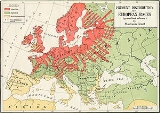
The Passing of the Great Race
Encyclopedia
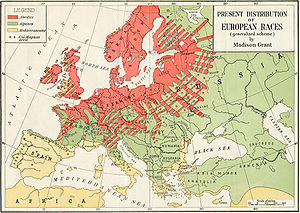
Scientific racism
Scientific racism is the use of scientific techniques and hypotheses to sanction the belief in racial superiority or racism.This is not the same as using scientific findings and the scientific method to investigate differences among the humans and argue that there are races...
written by the American eugenicist
Eugenics
Eugenics is the "applied science or the bio-social movement which advocates the use of practices aimed at improving the genetic composition of a population", usually referring to human populations. The origins of the concept of eugenics began with certain interpretations of Mendelian inheritance,...
, lawyer, and amateur anthropologist Madison Grant
Madison Grant
Madison Grant was an American lawyer, historian and physical anthropologist, known primarily for his work as a eugenicist and conservationist...
in 1916. The book was largely ignored when it first appeared but went through several revisions and editions; it was never a best seller. The book put forward Grant's theory of "Nordic superiority
Nordic theory
The Nordic race is one of the racial subcategories into which the Caucasian race was divided by anthropologists in the first half of the 20th century...
" and argued for a strong eugenics program in order to save the waning "Nordics" from inundation of other race types. Grant's propositions to create a strong eugenics program for the "Nordic" population to survive was at the time repudiated by Americans in the 1930s and Europeans after 1945.
First section
The first section dealt with the basis of race as well as Grant's own stances on political issues of the day. These centered around the growing numbers of immigrants from Eastern and Southern Europe. Grant claimed that the members of contemporary American Protestant society who could trace their ancestry back to Colonial times were being out-bred by immigrant and inferior racial stocks. Grant reasoned that America has always been a Nordic country, consisting of Nordic immigrants from England, Scotland, and the Netherlands in Colonial times and of Nordic immigrants from Ireland and Germany in later times. Grant felt that Eastern and Southern Europe were underdeveloped and a source of racial stocks unqualified for the Nordic political structure of the US. Grant was also interested in the impact of the expansion of America's Black population into the urban areas of the North.Grant reasoned that the new immigrants were of different races and were creating separate societies within America including ethnic lobby groups, criminal syndicates, and political machines which were undermining the socio-political structure of the country and in turn the traditional Anglo-Saxon colonial stocks, as well as all Nordic stocks. His analysis of population studies, economic utility factors, labor supply, etc. purported to show that the consequence of this subversion was evident in the decreasing quality of life, lower birth-rates, and corruption of the contemporary American society. He reasoned that the Nordic races would become extinct and America as it was known would cease to exist being replaced by a fragmented country or a corrupt caricature of itself.
Second section
The second part of the book dealt with the history of the three European races: Nordic, Alpine, and Mediterranean, as well as their physical and mental characteristics. This part of the book tied together strands of thinking regarding Aryan migration theory, ethnology, anthropology, and history into a broad survey of the historical rise and fall, and expansion and retraction, of the European races from their homelands. It similarly connected the history of America with that of Europe, especially its Nordic nations.Nordic theory
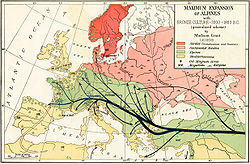
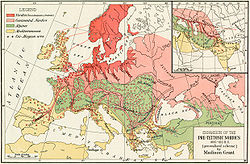
Racial hygiene
Racial hygiene was a set of early twentieth century state sanctioned policies by which certain groups of individuals were allowed to procreate and others not, with the expressed purpose of promoting certain characteristics deemed to be particularly desirable...
detailing the "racial history" of the world. He drew on the scientific theories of genetics
Genetics
Genetics , a discipline of biology, is the science of genes, heredity, and variation in living organisms....
and Darwinian evolution, as well as the writings of previous eugenicists and racialist authors, to create a clearly-written synthesis aimed at the general reader.
In summary the book elaborated Grant's interpretation of contemporary anthropology and history, which he saw as revolving chiefly around the idea of "race" rather than environment. He specifically promoted the idea of the Nordic race as a key social group responsible for human development; thus the subtitle of the book was The racial basis of European history. Grant also was an avid eugenicist
Eugenics
Eugenics is the "applied science or the bio-social movement which advocates the use of practices aimed at improving the genetic composition of a population", usually referring to human populations. The origins of the concept of eugenics began with certain interpretations of Mendelian inheritance,...
, advocating separation, quarantine and eventual collapse of "undesirable" traits and "worthless race types" from the human gene pool and the promotion, spread, and eventual restoration of desirable "traits" and "worthwhile race types" conducive to Nordic society:
A rigid system of selection through the elimination of those who are weak or unfit — in other words social failures — would solve the whole question in one hundred years, as well as enable us to get rid of the undesirables who crowd our jails, hospitals, and insane asylums. The individual himself can be nourished, educated and protected by the community during his lifetime, but the state through sterilization must see to it that his line stops with him, or else future generations will be cursed with an ever increasing load of misguided sentimentalism. This is a practical, merciful, and inevitable solution of the whole problem, and can be applied to an ever widening circle of social discards, beginning always with the criminal, the diseased, and the insane, and extending gradually to types which may be called weaklings rather than defectives, and perhaps ultimately to worthless race types.
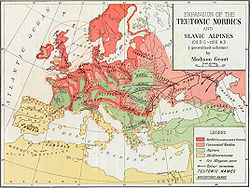
By 1937 the book had sold only 17,000 copies in the U.S. and had not received good reviews. It was rarely cited. Spiro (2009) explains its failure came because its celebration of Nordic triumphs rang hollow against the German atrocities in Belgium, and Americans did not accept its anti-democratic and anti-Christian message.
Grant's view of Nordic theory
Nordic theoryNordic theory
The Nordic race is one of the racial subcategories into which the Caucasian race was divided by anthropologists in the first half of the 20th century...
, in Grant's formulation, was largely copied from the work of Arthur de Gobineau
Arthur de Gobineau
Joseph Arthur Comte de Gobineau was a French aristocrat, novelist and man of letters who became famous for developing the theory of the Aryan master race in his book An Essay on the Inequality of the Human Races...
that appeared in the 1850s, except that Gobineau used the study of language while Grant used physical anthropology to define races. Both divided mankind into primarily three distinct races: Caucasoids
Caucasian race
The term Caucasian race has been used to denote the general physical type of some or all of the populations of Europe, North Africa, the Horn of Africa, Western Asia , Central Asia and South Asia...
(based in Europe, North Africa, and Western Asia), Negroids (based in Sub-Saharan Africa), and Mongoloids
Mongoloid race
Mongoloid is a term sometimes used by forensic anthropologists and physical anthropologists to refer to populations that share certain phenotypic traits such as epicanthic fold and shovel-shaped incisors and other physical traits common in East Asia, the Americas and the Arctic...
(based in Central and Eastern Asia). Nordic theory, however, further subdivided Caucasoids into three groups: Nordics (who inhabited Scandinavia, northern Germany, Austria-Hungary, parts of England, Scotland and Ireland, Holland, Flanders, parts of northern France, parts of Russia, and northern Poland, and parts of Central and Southern Europe), Alpines
Alpine race
The Alpine race is an historical racial classification or sub-race of humans, considered a branch of the Caucasian race. The term is not commonly used today, but was popular in the early 20th century.-History:...
(whose territory stretched from central Europe, parts of northern Italy, southern Poland to the Balkans/Southeastern Europe, central/southern Russia, parts of England, Scotland, Wales and Ireland, Turkey and even into Central Asia), and Mediterraneans
Mediterranean race
The Mediterranean race was one of the three sub-categories into which the Caucasian race and the people of Europe were divided by anthropologists in the late nineteenth and early twentieth centuries, following the publication of William Z. Ripley's book The Races of Europe...
(who inhabited southern France, the Iberian peninsula, southern Italy, Greece, Wales, parts of England, Ireland and Scotland, North Africa, and parts of the Middle East and Central and South Asia).

The Nordic, in his hypothesis, was "Homo europaeus, the white man par excellence. It is everywhere characterized by certain unique specializations, namely, wavy brown or blond hair and blue, gray or light brown eyes, fair skin, high, narrow and straight nose, which are associated with great stature, and a long skull, as well as with abundant head and body hair." Grant categorized the Alpines as being the lowest of the three European races, with the Nordics as the pinnacle of civilization.
The Nordics are, all over the world, a race of soldiers, sailors, adventurers, and explorers, but above all, of rulers, organizers, and aristocrats in sharp contrast to the essentially peasant character of the Alpines. Chivalry and knighthood, and their still surviving but greatly impaired counterparts, are peculiarly Nordic traits, and feudalism, class distinctions, and race pride among Europeans are traceable for the most part to the north.
Grant, while aware of the "Nordic Migration Theory" into the Mediterranean, appears to reject this theory as an explanation for the high civilization features of the Greco-Roman world
Greco-Roman world
The Greco-Roman world, Greco-Roman culture, or the term Greco-Roman , when used as an adjective, as understood by modern scholars and writers, refers to those geographical regions and countries that culturally were directly, protractedly and intimately influenced by the language, culture,...
.
The mental characteristics of the Mediterranean race are well known, and this race, while inferior in bodily stamina to both the Nordic and the Alpine, is probably the superior of both, certainly of the Alpines, in intellectual attainments. In the field of art its superiority to both the other European races is unquestioned.
Yet, while Grant allowed Mediterraneans to have abilities in art, as quoted above, later in the text in a sop to Nordic Migration Theorists, he remarked that true Mediterranean achievements were only through admixture with Nordics:
This is the race that gave the world the great civilizations of Egypt, of Crete, of Phoenicia including Carthage, of Etruria and of Mycensean Greece. It gave us, when mixed and invigorated with Nordic elements, the most splendid of all civilizations, that of ancient
Hellas, and the most enduring of political organizations, the Roman State.
To what extent the Mediterranean race entered into the blood and civilization of Rome, it is now difficult to say, but the traditions of the Eternal City, its love of organization, of law and military efficiency, as well as the Roman ideals of family life, loyalty, and truth, point clearly to a Nordic rather than to a Mediterranean origin.
In this manner, Grant appeared to be studiously following scientific theory. Critics warned that Grant used uncritical circular reasoning. His desirable characteristics of a people – "family life, loyalty, and truth" were claimed to be exclusive products of the "Nordic race". Thus, whenever such traits were found in a non-Nordic culture, Grant said that was evidence of a Nordic influence or admixture, rather than (as would be the proper scientific method
Scientific method
Scientific method refers to a body of techniques for investigating phenomena, acquiring new knowledge, or correcting and integrating previous knowledge. To be termed scientific, a method of inquiry must be based on gathering empirical and measurable evidence subject to specific principles of...
) casting doubt on their supposed exclusive Nordic origin.
Reception and influence
Grant researched the published scientific literature, especially in anthropology, to support his notions of Nordic racialism.According to Grant, Nordics were in a dire state in the modern world, where due to their abandonment of cultural values rooted in religious or superstitious proto-racialism, they were close to committing "race suicide" by miscegenation, and to being out-bred by inferior stock which was taking advantage of the transition. Nordic theory was strongly embraced by the racial hygiene
Racial hygiene
Racial hygiene was a set of early twentieth century state sanctioned policies by which certain groups of individuals were allowed to procreate and others not, with the expressed purpose of promoting certain characteristics deemed to be particularly desirable...
movement in Germany in the early 1920s and 1930s; however, they typically used the term "Aryan
Aryan
Aryan is an English language loanword derived from Sanskrit ārya and denoting variously*In scholarly usage:**Indo-Iranian languages *in dated usage:**the Indo-European languages more generally and their speakers...
" instead of "Nordic", though the principal Nazi ideologist, Alfred Rosenberg
Alfred Rosenberg
' was an early and intellectually influential member of the Nazi Party. Rosenberg was first introduced to Adolf Hitler by Dietrich Eckart; he later held several important posts in the Nazi government...
, preferred "Aryo-Nordic" or "Nordic-Atlantean". Stephen Jay Gould
Stephen Jay Gould
Stephen Jay Gould was an American paleontologist, evolutionary biologist, and historian of science. He was also one of the most influential and widely read writers of popular science of his generation....
described The Passing of the Great Race as "The most influential tract of American scientific racism."
Grant was involved in many debates on the discipline of anthropology
Anthropology
Anthropology is the study of humanity. It has origins in the humanities, the natural sciences, and the social sciences. The term "anthropology" is from the Greek anthrōpos , "man", understood to mean mankind or humanity, and -logia , "discourse" or "study", and was first used in 1501 by German...
against the anthropologist Franz Boas
Franz Boas
Franz Boas was a German-American anthropologist and a pioneer of modern anthropology who has been called the "Father of American Anthropology" and "the Father of Modern Anthropology." Like many such pioneers, he trained in other disciplines; he received his doctorate in physics, and did...
, who advocated cultural anthropology
Cultural anthropology
Cultural anthropology is a branch of anthropology focused on the study of cultural variation among humans, collecting data about the impact of global economic and political processes on local cultural realities. Anthropologists use a variety of methods, including participant observation,...
in contrast to Grant's "hereditarian" branch of physical anthropology
Physical anthropology
Biological anthropology is that branch of anthropology that studies the physical development of the human species. It plays an important part in paleoanthropology and in forensic anthropology...
. Boas and his students were strongly opposed to racialist notions, holding that any perceived racial inequality was due to social rather than biological factors.
Grant advocated restricted immigration to the United States through limiting immigration from East Asia and Southern Europe; he also advocated efforts to purify the American population though selective breeding. He served as the vice president of the Immigration Restriction League
Immigration Restriction League
The Immigration Restriction League, was founded in 1894 by people who opposed the influx of "undesirable immigrants" that were coming from southern and eastern Europe. They felt that these immigrants were threatening what they saw as the American way of life and the high wage scale...
from 1922 to his death. Acting as an expert on world racial data, Grant also provided statistics for the Immigration Act of 1924
Immigration Act of 1924
The Immigration Act of 1924, or Johnson–Reed Act, including the National Origins Act, and Asian Exclusion Act , was a United States federal law that limited the annual number of immigrants who could be admitted from any country to 2% of the number of people from that country who were already...
to set the quotas on immigrants from certain European countries. Even after passing the statute, Grant continued to be irked that even a smattering of non-Nordics were allowed to immigrate to the country each year. He also assisted in the passing and prosecution of several anti-miscegenation laws
Anti-miscegenation laws
Anti-miscegenation laws, also known as miscegenation laws, were laws that enforced racial segregation at the level of marriage and intimate relationships by criminalizing interracial marriage and sometimes also sex between members of different races...
, notably the Racial Integrity Act of 1924
Racial Integrity Act of 1924
On March 20, 1924 the Virginia General Assembly passed two laws that had arisen out of contemporary concerns about eugenics and race: SB 219, entitled "The Racial Integrity Act" and SB 281, "An ACT to provide for the sexual sterilization of inmates of State institutions in certain cases",...
in the state of Virginia
Virginia
The Commonwealth of Virginia , is a U.S. state on the Atlantic Coast of the Southern United States. Virginia is nicknamed the "Old Dominion" and sometimes the "Mother of Presidents" after the eight U.S. presidents born there...
, where he sought to codify his particular version of the "one-drop rule
One-drop rule
The one-drop rule is a historical colloquial term in the United States for the social classification as black of individuals with any African ancestry; meaning any person with "one drop of black blood" was considered black...
" into law.
Grant became a part of popular culture in 1920s America. Author F. Scott Fitzgerald
F. Scott Fitzgerald
Francis Scott Key Fitzgerald was an American author of novels and short stories, whose works are the paradigm writings of the Jazz Age, a term he coined himself. He is widely regarded as one of the greatest American writers of the 20th century. Fitzgerald is considered a member of the "Lost...
featured a reference to Grant in The Great Gatsby
The Great Gatsby
The Great Gatsby is a novel by the American author F. Scott Fitzgerald. First published in1925, it is set on Long Island's North Shore and in New York City from spring to autumn of 1922....
. Tom Buchanan was reading a book called The Rise of the Colored Empires by "this man Goddard", a combination of Passing of the Great Race (Grant) and his colleague Lothrop Stoddard
Lothrop Stoddard
Theodore Lothrop Stoddard was an American historian, journalist, racial anthropologist, eugenicist, political theorist and anti-immigration advocate who wrote a number of books which are cited by historians as prominent examples of early 20th-century scientific racism.- Biography :Stoddard was...
's The Rising Tide of Color Against White World Supremacy (Stoddard; Grant wrote the introduction to Stoddard's book). "Everybody ought to read it", the character explained, "The idea is if we don't look out the white race will be — will be utterly submerged. It's all scientific stuff; it's been proved."
Americans turned against Grant's ideas in the 1930s, his book no longer sold and his supporters fell away. In Europe, however, Nordic theory received a large boost during the 1930s by the racialist influence of the Nazi in Germany and other countries. Grant's book and the genre in general was read in Germany, but eugenicists increasingly turned to Nazi Germany for leadership. Heinrich Himmler
Heinrich Himmler
Heinrich Luitpold Himmler was Reichsführer of the SS, a military commander, and a leading member of the Nazi Party. As Chief of the German Police and the Minister of the Interior from 1943, Himmler oversaw all internal and external police and security forces, including the Gestapo...
's Lebensborn
Lebensborn
Lebensborn was a Nazi programme set up by SS leader Heinrich Himmler that provided maternity homes and financial assistance to the wives of SS members and to unmarried mothers, and also ran orphanages and relocation programmes for children.Initially set up in Germany in 1935, Lebensborn expanded...
Society was formed to preserve typical Nordic genes, such as blond hair and blue eyes, by sheltering blond, blue-eyed women.
Further reading
- Baker, Lee D. From Savage to Negro: Anthropology and the Construction of Race. University of California Press, 1998
- Guterl, Matthew Press. The Color of Race in America, 1900-1940. Cambridge, MA: Harvard University Press, 2001.
- Spiro, Jonathan. Defending the Master Race: Conservation, Eugenics, and the Legacy of Madison Grant (University Press of New England, 2009)
External links
- Passing of the Great Race available online
- Excerpts from Passing of the Great Race used at the Nuremberg Trials
- Passing of the Great Race (1921 ed.), available via Google Books

